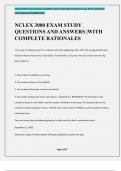Exam (elaborations)
NCLEX 3000 EXAM STUDY QUESTIONS AND ANSWERS |WITH COMPLETE RATIONALES
- Course
- Institution
NCLEX 3000 EXAM STUDY QUESTIONS AND ANSWERS |WITH COMPLETE RATIONALES The nurse is checking a client's I.V. infusion rate at the beginning of her shift. The nursing Kardex states that the infusion should run at 125 ml/hour. To verify the I.V. drip rate, the nurse must know the drip factor, whi...
[Show more]



